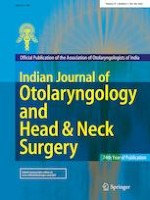Erschienen in:

17.06.2022 | Original Article
Assessment of Nasal Smear Eosinophil Counts in Allergic Rhinitis: How Useful is it?
verfasst von:
G. Usha, Indranil Pal, Saumitra Kumar, Bibhas Mondal, Gandhari Basu
Erschienen in:
Indian Journal of Otolaryngology and Head & Neck Surgery
|
Ausgabe 4/2022
Einloggen, um Zugang zu erhalten
Abstract
Objectives: The aim was to find the relationship between nasal smear eosinophil (NSE) counts and allergic rhinitis (AR) along with the impact of treatment on peak nasal inspiratory flow rates and symptom scores in these patients. Material and methods: An observational, comparative study was carried out with 75 patients of AR. Nasal smears were drawn and eosinophil counts were estimated. Nasal symptoms were assessed and compared by visual analogue scale (VAS) and peak nasal inspiratory flow (PNIF) rates before and after treatment. Equal number of healthy individuals formed the control group. Results: There was a strong association between increase in eosinophil count in nasal smears and AR (p = 0.000). A NSE count of 0.2/HPF had a specificity of 98.7%, sensitivity of 53.3%, and positive predictive value of 97.6% in the diagnosis of AR. The mean VAS scores for nasal obstruction improved from 7.35 to 1.01 and the mean peak nasal inspiratory flow from 69.00 L/min to 103.73 L/min (p < 0.0001) after treatment. The mean NSE counts reduced from 4.20/HPF to 0.090/HPF proving a strong correlation between improvement of symptom scores and NSE counts (p = 0.000) in AR. The study also determined that a PNIF value of ≤ 77.50 L/min can be used as a cut off for diagnosing nasal obstruction in these patients. Conclusion: A NSE count of ≥ 0.2 /HPF is to be considered as diagnostic of AR. Nasal congestion is the commonest symptom associated with AR and addition of systemic decongestant is required for management of these patients.